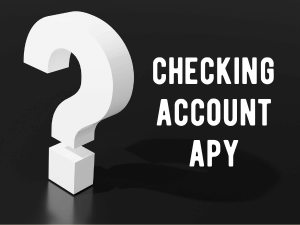Understanding Checking Account APY: How Does It Work?

Unlock the mystery behind those two seemingly similar numbers on your checking account: interest rate and APY. Discover why the Annual Percentage Yield (APY) is often higher and why it matters more for your bottom line. This eye-opening guide demystifies compound interest, reveals the hidden impact of fees, and shows you how to maximize your earnings. Learn the crucial questions to ask when choosing an interest-bearing account and why MIDFLORIDA Credit Union's High Yield Checking account might be your ticket to better returns.
This blog is for informational purposes only and not an offer of any specific account or service. For current details on our checking accounts, including terms and fees, please visit midflorida.com or speak with a representative. Account features and conditions may change. Membership eligibility required.
Ever notice how interest-bearing accounts seem to have two different rates?
Take the MIDFLORIDA Credit Union High Yield Checking account, for example. There’s one interest rate and another slightly higher APY.
So what is this checking account APY? Why is it higher than the interest rate?
We’ll explain how APYs work for your checking account and show you how you can open an account with MIDFLORIDA and receive a free $200 bonus.1
Start your application with MIDFLORIDA Credit Union.
How interest works
To explain APY, you have to know how interest works. The concept is actually pretty simple: Interest is a fee that a financial institution pays for the use of its depositors’ money.
Why do savings accounts earn interest?
When you put your money in a MIDFLORIDA Regular Savings account, you’re setting it aside for the financial institution to use. As compensation, they pay you a percentage of the money in your account.
Accounts with higher interest rates usually have a high minimum deposit requirement. They might also require you to keep money in the account for some time, like with certificates of deposit.
APY vs. interest
When financial institutions list their interest rates, they usually provide two numbers.
- The interest rate: The percentage of your money you’ll get paid annually.
- The APY: “Annual Percentage Yield,” the rate your money will earn annually if you include compound interest.
For instance, let's say you deposit $1,000 in an account with a 4% annual interest rate. After one year with simple interest, you'll have earned $1,040. With interest compounded annually; you'd also have $1,040. However, if the interest is compounded more frequently, say monthly, you'd end up with $1,040.74.
Lenders promote the APY of interest-bearing accounts to show members how much they could earn yearly, accurately reflecting the frequency of compounding.
Should you pay attention to the interest rate or APY?
Overall, you should pay more attention to the APY than the interest rate. This is especially true if you’re keeping money in your account for longer periods of time.
However, you should consider a few things when looking at the APY.
How often does the interest compound?
The more often interest is compounded, the higher the APY compared to the interest rate.
Look for accounts that compound interest at least every month.
Is the APY fixed or variable?
Most APYs are variable. However, some accounts may offer a fixed APY as a promotional offer.
If an APY is fixed, the interest rate remains constant for the specified term, providing predictability for your earnings. This can be helpful for short-term financial planning, though the real value of your money may still be affected by inflation over time.
A variable APY can change in response to economic conditions. While this means your rate could increase if market rates rise, it also means your earnings could decrease if rates fall. This flexibility can be advantageous or disadvantageous depending on market trends.
What fees does the account charge?
High fees can eat up your interest.
Keep an eye out for fees like:
- Maintenance fees
- Monthly fees
- Annual fees
- Inactivity fees
Take advantage of MIDFLORIDA’s High Yield Checking account
When considering an interest-bearing account, the Annual Percentage Yield (APY) is a key factor. This rate reflects your potential earnings, including compound interest. Be sure to consider both the compounding frequency and any account fees, as these can significantly impact your overall returns. The APY calculates how much money you’ll earn if you include compound interest.
MIDFLORIDA offers an excellent opportunity to maximize your earnings with our High-Yield Checking account. This account combines the convenience of everyday banking with competitive interest rates, helping your money work harder for you.
Additionally, if you’re a new member and open up a MIDFLORIDA Free Checking account, you could get a $200 bonus1 if you meet the conditions.
Regardless of which account you open, you can count on getting the personal service that so many big banking institutions have forgotten these days.
Further Reading Recommendations
- Offer valid as of September 1, 2024, and may be canceled at any time. MIDFLORIDA Credit Union membership and eligibility requirements apply. Paper statements are not routinely provided for Free Checking accounts. See associate for details regarding fees and terms. To qualify for the $200 incentive, you must open a new Free Checking account with direct deposit ($500 cumulative which must post within 60 days of account opening; cash transfer app deposits do not qualify); accept and open online banking, eStatement, and a debit card; and complete 5 debit card purchase transactions which must post in one calendar month (to be completed within the first 60 days of account opening). No dividends are paid on Free Checking. Annual Percentage Yield is 0.00%. Limit one incentive per Social Security number. Past checking account holders and previous recipients of checking account incentives are ineligible. The incentive will be deposited to new Free Checking account after the qualifications have been met, and will be reported to the IRS. Minimum to open Free Checking is $50.